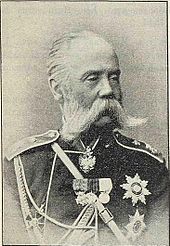Barclay de Tolly-Weymarn
The Barclay de Tolly-Weymarn princes were a Baltic aristocratic family who achieved high esteem, especially in Russia .
history
The lineage of the princes Barclay de Tolly-Weymarn was an agnatic branch of the Weymar family from Lübeck , whose lineage includes the Lübeck merchant Jürgen Weimar and his son, Anton Weymar († before 1629), merchant in Lübeck, Mitau and Pernau and ducal Courland rentmaster begins. 1693 is Swedish nobility to the family arrived , whereupon they in 1741 when oeselschen knighthood and in 1839 in the Estonian knighthood enrolled.
The Imperial Russian Field Marshal General Michael Andreas Barclay de Tolly was elevated to the status of a Russian prince as a result of his outstanding achievements during the Wars of Liberation in 1815 . However, after his line had already started with his son Prince Magnus Barclay de Tolly (1797–1871), Imperial Russian colonel and wing adjutant of Tsar Alexander II , the title of prince was initially given by a Senate decree on May 17, 1872 and on November 2, 1872 by decree of the tsar on Michael Andreas Barclay de Tolly's sister-grandson and great-nephew Alexander Magnus Friedrich von Weymarn (1824-1905), Imperial Russian general of the infantry, who henceforth, like the members of his house, the title prince with the salutation exalted and the name Barclay de Tolly -Weymarn , inherited. With his grandson, Prince Nikolaus Barclay de Tolly-Weymarn (1892–1964), Imperial Russian Rittmeister in the Life Guard Hussar regiment, the family died out.
The Beckhof Family Fideikommiss in what was then Fellin County was owned by the family until the Estonian land reform in 1919 . In 1883 the family had registered with the Livonian knighthood .
coat of arms
The princely coat of arms (1880) is quartered and covered with a split heart shield , in it a golden rafter (Barclay de Tolly) accompanied by three (2.1) golden crosses in blue , on the left in the field divided by black and red a lion of confused color, who wields a silver ax (Weymarn) under a golden shield head , inside the Russian black double-headed eagle covered with breast shield , inside the Moscow coat of arms; 1 in red an upright gold-tipped sword with Russian inscription 20 Январь 1814 ( January 20, 1814 ); 2 in red an upright gold-studded green field marshal's baton studded with Russian eagles and wound with laurel branches ; 3 in silver on a green ground a French cannon , behind it three blue-red-blue flags and a sloping red standard ; 4 in silver a red wall with a tower and a red lion in a black gate. Five helmets : 1 with blue and gold covers a wing marked like the right field of the heart shield; 2 with red and silver covers a resting armored golden sword arm; 3 princely crowned with black and gold covers of the double-headed eagle; 4 with red-silver blankets a resting armored golden arm with field marshal's baton; 5 with black and gold covers the divided lion of changing colors (Weymarn) growing with a silver ax. Shield holder : Two golden lions. Motto : верность и терпение ( loyalty and patience ). - Prince's hat and coat.

Trunk line
- Prince Alexander Magnus Friedrich Barclay de Tolly-Weymarn (1824–1905), Fideikommissherr auf Beckhof, Herr auf Kaskowo, Imperial Russian Infantry General and Adjutant General of the Emperor, ⚭ 1849 Baron Marie Friederike von Seddeler (1825–1868), daughter of the Imperial Russian Lieutenant General Baron Ludwig von Seddeler
- Princess Alexandrine ( Ada ) Auguste Olga Barclay de Tolly-Weymarn (1854–1945), writer, ⚭ 1883 Alexis von Krusenstjerna adH Haggud (1859–1909), lord of Stäflö, Kalmar Lan , imperial Russian colonel
- Prince Ludwig ( Louis ) Alexander Michael Barclay de Tolly-Weymarn (1859–1903), District Marshal of Peterhof , Imperial Russian Colonel of the Life Guard Regiment of the Grodnos Hussars and attaché at the embassy in Paris, ⚭ 1882 Katharina Tschernyshev (1861–1925), daughter of the Imperial Russian Major General Feodor Sergejewitsch Tschernyshev
- Princess Katharina ( Carina ) Anna Barclay de Tolly-Weymarn (1887–1984), ⚭I 1909 Charles Loise Victor Ottino (1878–1918), landowner in Stubbington, County Hampshire ; ⚭II 1926 Paul Alexandrowitsch Schischkow (1887–1958), Dipl.-Ing. Ship and aircraft construction
- Princess Marie ( Mira ) Barclay de Tolly-Weymarn (1890–1975), ⚭ 1906 Vladimir Nikolajewitsch Semigradow (1872–1925), Lord of Buschory, Bessarabia Governorate ; ⚭II 1918 Count Vladimir (Waldemar) Alexandrowitsch Armfelt (1895–1985), Imperial Russian staff officer of the Life Guard Dragoon Regiment
- Prince Nikolaus Barclay de Tolly-Weymarn (1892–1964), Fideikommissherr on Beckhof, Lord on Stenfors, Kronobergs län , Imperial Russian Rittmeister in the Life Guard Hussar Regiment, ⚭I Margarethe Hot; ⚭II 1933 Sonja Gudrun Elisabeth Ingelsson (1903–1968), daughter of the royal Norwegian consul and industrialist Carl Wilhelm Ingelsson
- Princess Marie ( Mira ) Georgia Augusta Barclay de Tolly-Weymarn (1863–1939), ⚭ 1888 Baron Georg Christian Joachim von Thuemmler (1858–1922), Lord of Selka , ducal chamberlain of Saxony-Altenburg and legal knight of the Order of St. John
literature
- Genealogical Handbook of the Baltic Knighthoods (New Series) , Hamburg 2012, Vol. 2, pp. 41–51
- Genealogisches Handbuch der Oeselschen Ritterschaft, Tartu 1935, pp. 441–443
- Genealogisches Handbuch des Adels (Fü), CA Starke Verlag , Vol. IV, Limburg (Lahn) 1956, pp. 358-361; Vol. XI, 1980, pp. 352-353
- Gothaisches Genealogisches Taschenbuch (H), Justus Perthes , Gotha 1938, 1940, 1942
Individual evidence
- ↑ Nicolai von Essen (ed.): Genealogisches Handbuch der Oeselschen Ritterschaft, Tartu, 1935, pp. 423-439
- ^ Genealogical manual of the Baltic knighthoods, part 2, 3: Estland, Görlitz 1930, pp. 264–276
- ^ Genealogical manual of the Baltic knighthoods. (New episode), Hamburg 2012, Vol. 2, pp. 28–31
- ^ Baltic Historical Commission (ed.): Entry on Weymarn, Alexander Magnus Friedrich v., Since May 31, 1872 Prince Barclay de Tolly-W .. In: BBLD - Baltic biographical lexicon digital
